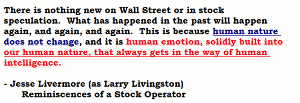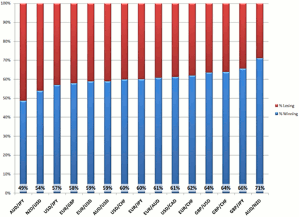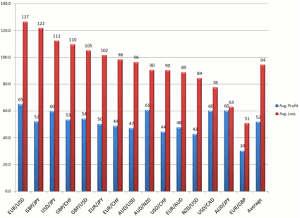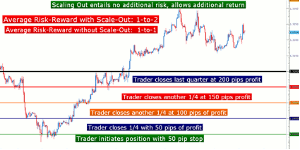Falling victim to emotions has plagued traders for as long as markets have existed, and in this three-part series, James Stanley of DailyFX.com shares ideas for how traders can look to overcome these mistakes.
It's an unfortunate fact, but the path to becoming a profitable trader is rarely a direct one. More normally, traders face a series of setbacks highlighted by interspersed moments of glory.
Some will make it through the 'growing pains,' while many others will not. This is just a part of trading, and it's been this way for a very long time. The book Reminiscences of a Stock Operator shows us this; as this book champions a series of stories set around 100 years ago. One of my favorite quotes from the book:
There are a few different layers to this quote. First, the problems faced by traders today, are likely similar to problems faced by traders in the past; whether t be 10, 20, or 100 years ago. The reason why is simple.because regardless of technological change or innovation we, as human beings, are still human beings. Secondly, emotions are often what get in the way of intelligence, or making the 'right' decisions.
This article series is going to look at the top three mistakes made by most traders. We're going to incorporate data from the DailyFX Traits of Successful Traders series to validate each thesis, and we're going to include primary ways that traders can look to address these potential "problem areas."
The Biggest Mistake
Before we get to the mistake itself, I want you to think about the last really bad trade that you had. I know digging up painful memories isn't fun, but self-improvement rarely is.
Why did that trade work out so badly? Did you violate your plan or allow the position to move massively beyond your initial stop value? Did you have an initial stop? Did you have a plan on the trade before you entered; as in, did you know what price levels you wanted to get out of the position?
The reason all of these questions are relevant is because of how pervasive the number one mistake forex traders make can be, and how each of these questions pertain to this ill.
The biggest mistake made by traders is faulty risk-reward ratios, and there are likely a few different reasons for this; but just like Jesse Livermore said in Reminiscences of a Stock Operator it is "human emotion, solidly built into human nature, that always gets in the way of human intelligence."
Human beings like to win. I'm in this group too; I hate to lose, and I think most good traders should be the same way.
But this drive to win each individual trade can be the same thing causing traders to lose money and become unprofitable. Because, you see, traders are successful in winning more often than they lose. The below chart is taken directly from the number one mistake forex traders make.
Winning percentages (in blue) in the most popular currency pairs
As I said earlier, human beings like to win. And from the above graphic, you can see how traders won more often than they lost in every currency pair in the observed data with the exception of AUD/JPY (at 49% winning).
So, these traders must've felt great, right?
Unfortunately not; despite the fact that these traders won more often than they lost, they still lost money. And this goes right back to that very human, emotional drive to try to win on each and every single trade.
Remember back to that last really bad trade. Why did you violate your plan? Why did you allow this one, single trade to take more away from you than you wanted it to?
Does this phrase ring a bell?
"If only price comes back to my entry, I'll close the position out and never do this again!"
This drive to win on each individual trade keeps us in positions that we probably shouldn't be staying in. It gets traders to hold on to losing positions for far too long simply for the hope of, eventually, being right.
NEXT PAGE: How to Prevent the Top Trading Mistake
|pagebreak|These trades are emotionally devastating, costly, and very counter-productive. And just one or two blow-ups can absolutely crush a trader's profit line.
Those blow-ups; these cases of lack of discipline are what cause the below chart to happen. In the graphic below, also taken from number one mistake forex traders make, you'll see the average win in each pair along with the average loss.
The average loss (in red) outstrips the average win (in blue) in every observed currency pair
Notice how there was not a single currency pair in which traders averaged a larger win than the average loss that was faced.
It's the fact that these average losses are so outsized relative to the average win that disallows the winning percentages we looked at previously to amount to profitability.
In some cases, traders were winning nearly two out of every three trades (GBP/JPY with a 66% winning percentage). But, because these traders were losing about $2.34 on each loss for every $1 made on each win; even winning 66% of the time didn't help these traders find profitability.
Did these traders go into GBP/JPY trades willing to lose $2.34 if they were wrong, if they could only make $1 if they were right?
Likely not-instead, they're allowing human emotions to get in the way of intelligence. When a trade moves against them, they hold on, hoping that the position comes back. This is being greedy, when in fact, they should be fearful.
Or, if the trade moves in their favor, they quickly close the position for fear of the trade moving against them and becoming a loss. This is being fearful, when in fact; these traders should be greedy (given that their trade idea, up to that point, has proven correct).
How to Prevent the Top Trading Mistake
First and foremost, traders have to realize that markets are unpredictable.
It doesn't matter how strong your analysis, or how great any one trade idea might be; nobody knows exactly what will happen in the future.
Analysis can help us get the probabilities on our side, even if just a little bit, but there will still be cases where we'll be wrong, and we have to know what to do here rather than just 'hope' that prices will come back in our favor.
If you don't have an exit plan before you enter a position-you need one. You can place a stop on the position at the entry, and this serves as your "line-in-the-sand."
Place the stop at a price level in which you'll feel comfortable admitting that the trade idea was unsuccessful; an area to "stem the bleeding," on the position from becoming an unbearable loss.
After the stop is set, traders then need to look at profit targets at least as large as the amount put up to risk on the position, and this can be done in a few different ways.
Traders can use limit orders on the position as profit targets, so that once price reaches that level, the trade is closed out profitably.
Traders can also look to move the stop to breakeven after an appropriate amount of profit is accumulated in the position. This way, if prices move against the trader, at the very least, they won't have to face a financial loss on the position (since the trade is being exited at the initial entry price).
A more advanced way of looking for profits is the scaling out approach. With this approach, the trader closes parts of the position as the trade moves further in their favor. This way, the trader can potentially look for a much larger return on the last parts of the position, but can still take some profits off-of-the-table as the trade moves in their favor.
Scaling-out can help traders look for greater profit targets without risking the entire position's profit
All of these ways can assist the trader in overcoming the number one mistake traders make. It will not feel comfortable at first, and you may lose more often than you win. But that's ok. This is a long-term marathon, not a short-term footrace. Plan your trade, and trade your plan.
In our next piece, we'll take a look at another silent killer of traders' profit lines: Leverage.
By James Stanley, Trading Instructor, DailyFX.com

























